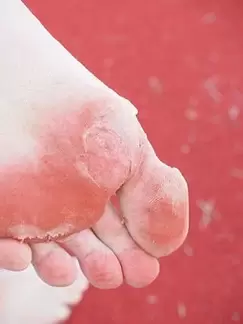Foot mycosis is the most common fungal infection of the skin today. There are three types of mycosis of the foot, or as it is called, fungus on the foot. And each type is localized in different parts of the foot and looks different.

How do you get toenail fungus?
Foot mycosis is caused by a fungus growing on the top layer of skin or. The fungus grows best in warm, humid places. For example - in the area between the toes. Foot fungus spreads very easily. In most cases, it is enough to touch the fingers or toes of an infected person to get sick. However, most fungal infections occur when people walk barefoot on dirty surfaces near pools or in the locker rooms of the same pool, gym and other similar items. Later, the fungus can remain in your shoes, especially if the shoes are too narrow and the air cannot circulate around your feet.
If you touch an object that is a fungus, you can then become a distributor of it and infect other people. And just because you can infect others does not mean that you can infect yourself. Doctors do not know why this happens, but everyone is prone to fungal infections of the feet. If you already have mycosis, you are more likely to be re-infected.
2. Symptoms of the fungus
Symptoms of mycosis of the feet may include burning and itching of the skin between the toes. The skin may tear and crack. Other symptoms of athlete's foot can vary depending on which athlete's foot is diagnosed.
The first type is an infection that causes symptoms between the fourth and fifth fingers at most. The skin becomes scaly, peels and cracks. In some cases, a bacterial infection can join the mycosis and make the skin condition worse.
The second type of fungus is a disease that can start with mild pain in the legs. Then the skin on the sole or bottom of the foot thickens and may crack. The toenail fungus also affects the nails as they progress. Nail fungus can thicken, break or even fall off. Fungal infections of the nails and skin of the feet should usually be treated differently.
Vesicular infection is the third type of athlete's foot. Typically, this type of athlete's foot begins with fluid-filled blisters under the skin. Bubbles usually form on the lower part of the foot, but can be found elsewhere on the foot. Along with this type of foot fungus, a bacterial infection can also develop.
3. Diagnosis of mycosis
To diagnose a foot fungus, a doctor, as a rule, should only examine the patient and study the medical history (symptoms, previous illnesses). If the fungus on your foot is rare or does not respond to treatment, your doctor may take a sample of your skin or nails for a fungus test.
Not all foot skin problems are mycoses or foot fungus. If you suspect that you have a fungus, but have never had such a disease before, it actually makes sense to consult a good dermatologist.
4. Treatment of the disease
Special lotions, creams or sprays are usually enough to treat athlete's foot. In severe cases, your doctor may prescribe prescription pills or topical medications to treat nail fungus. The fungus should be treated as prescribed by your doctor. This will be a guarantee that it is really possible to completely cure the fungus. In addition to the general treatment of foot mycosis, it is important to keep the feet clean and dry. Mushrooms need warm and humid places to grow.
To prevent the recurrence of mycosis and athlete's foot, you should use your own special shoes when going to the gym, swimming pool and so on. You can use talc or special products to dry your feet. Slippers or shoes that are not too tight will ensure adequate air circulation and moisture absorption.
























